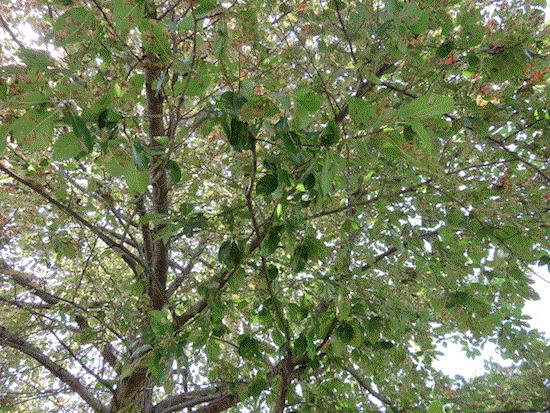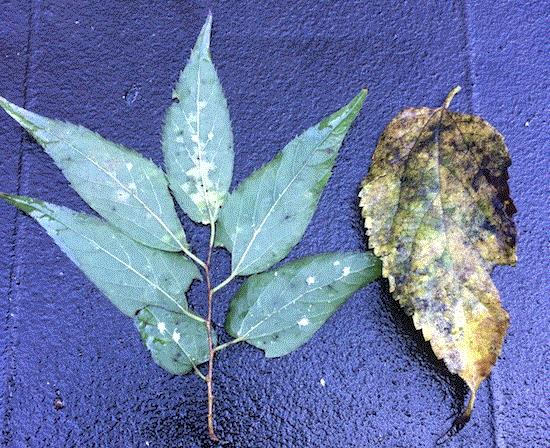Tupelo leaminers are creating shot holes
My friend Sheree Wright, horticulturist of Furman University, sent me a few pictures and asked me what these critters might be. She found something that looked like leafminer damage on tupelo (or black gum, depending on where you are) leaves on the university campus, and wondered if I might be able to identify the culprit.

Just about every leaf on this tupelo tree had three to four mines. I have never seen such a level of infestation! (Photo courtesy of Sheree Wright, Furman University)
Sheree was right. They were indeed leafminers—tupelo leafminer to be precise. Wait, tupelo leafminer? Leafminer + tupelo = tupelo leafminer? That’s a bit too convenient, isn't it? Well, hate to tell you: the way we entomologists name something is not exactly rocket science. Just to make y’all happy, the scientific name of this critter is Antispila nysaefoliella. Antispila means “opposite the spot” in Greek and the specific epithet (or species name) derives from its habit of feeding on tupelo (genus Nyssa) leaves.
The infested tupelo trees were shedding leaves, and Sheree asked if she needed to do something about the infestation. I like to give a spew (whether you like it or not) about a critter’s biology before giving management recommendations because how and when you treat is intimately related to pest biology. In this case, however, I wasn’t able to tell Sheree much. We just don't know much about the biology of the tupelo leafminer.
This species can be found in New England and along the eastern U.S. to eastern Texas—basically wherever tupelo is found. Tupelo leafminers belong to a family of small moths called the shield bearers (Heliozelidae). These leafminers generally create blotch mines on leaves, and each species is generally host species (meaning that the tupelo leafminer only attacks tupelo and closely related species). They are called the shield bearers because mature larvae tie the epidermis at the edge of their mines together into elliptical cases (like shields), cut along the edges of the cases, and drop to the ground to pupate. The mines are each left with an elliptical shot hole, which you can see in the close-up picture.

A telltale sign of tupelo leafminer infestation is the elliptical shot holes at the end of the mines. At this time, the leafminers have left the mines and management is likely not necessary. (Photo courtesy of Sheree Wright, Furman University)
Adult moths are small (3 mm or 0.1 in. in length), greyish to blackish, with one or several white stripes across its wings. The adults are active during the day. The caterpillars are flat and legless. Its biology is poorly known, but the tupelo leafminer likely has only one generation per year, with adults active in May and June, and the miners become more noticeable (and by this time the larvae have matured) in August and September. They pupate and overwinter in the cases or shields, and emerge as adults in the spring.
I also couldn't give a good answer to Sheree’s question on management. As in many situations, there is always the option of doing nothing. If the damage doesn’t bother anyone on campus, the easiest thing to do is to ignore it. The tupelo trees looked awful but the mines rarely have serious impacts on tree health. Treating against the mines might disrupt the natural biological control and cause more troubles down the road. In Sheree's case, the shot holes indicated that the leafminers have left the mines so there is nothing to treat for.
Adults are usually active in May, but the precise timing is difficult to pin down. Controlling the adults will be difficult. I would wait until June or July, i.e. just before the mines get too noticeable, to apply insecticides. Abamectin, chlorantraniliprole, cyantraniliprole and spinosad are known to be very effective against leaf-mining caterpillars. Neonicotinoids (acetamiprid, clothianidin and dinotefuran) are registered for controlling certain species of leaf-mining moths, but my experience suggests that efficacy of these products varies when used against caterpillars on large trees. Foliar spray may be the most effective method, and adding a spreader-sticker to the solution may help improve efficacy. But spraying the canopy of a large tree can be logistically challenging. Cherry picker, anyone? I don’t have data to suggest if soil drench with neonicotinoids and diamides (chloratraniliprole and cyantraniliprole) can be effective.

The summer of Asian woolly hackberry aphids
It seems like this is the week of the Asian woolly hackberry aphid, Shivaphis celti. I visited a farm in South Carolina where the owner was concerned about some “white fuzz” killing his hackberry trees. I was amazed by the number of aphids taking to the air (they looked like snowflakes!), and the extent of defoliation and sooty mold. I also received several emails and calls about them. A colleague forwarded an inquiry from another concerned individual about the aphids biting people and killing trees.
No worries. Asian woolly hackberry aphids DO NOT bite people. Bless his heart.

The white fuzzes on the leaves are the aphids. Feeding can cause chlorosis on leaves. The aphids also produce copious amounts of honeydew and sooty mold. (Photo by JC Chong)
The Asian woolly hackberry aphid only attacks members of the genus Celtis. Hackberry and sugarberry are the two species that are most severely impacted in my neck of the woods. In addition to the large amount of honeydew and sooty mold associated with the infestation, the aphids themselves are quite conspicuous because the bodies of both adults and nymphs are covered with a large amount of white, fuzzy wax. There are other species of aphids and sucking insects that would feed on hackberries and sugarberries and produce honeydew, but none of them produce as much white wax as the Asian woolly hackberry aphid.
This is an invasive species, probably introduced from Asia. The species was first found in Georgia in 1996 and Florida in 1997, and since then has spread to most of the Southeast, Texas and California.
The aphids overwinter as eggs on the twigs. Eggs hatch when hackberry leaves flush. The aphid populations contain only females in the spring and summer, and these females reproduce parthenogenetically (i.e. without mating). As a result, the populations build up very quickly and cause noticeable damage in late summer. Perhaps because of overcrowding or seasonal changes, the aphid populations begin to produce winged individuals in late summer so they can disperse to other trees. Winged males are produced in the fall. They disperse and mate with the wingless females, which produce overwintering eggs.
Just about all those I consulted with this week wanted to “do something” because the trees look awful and the dispersing aphids are annoying. I had to talk them down. First, we don't know what’s the best management approach against this species. We haven't done much research on how to best control the aphid population. I assume treating the hackberry trees with insecticides typically used for aphids (such as foliar sprays of horticultural oil and soil drenches with systemic neonicotinoids) would be effective but I don't have data to demonstrate that. Similar to treating for the tupelo leafminers, spraying a tall tree may not be logistically feasible. More importantly, the infestation typically does not cause long-term damage to the health of mature, healthy but otherwise infested trees. It’s likely that the hackberry trees will flush out just fine next spring.
I’d seen a few ladybeetle species feeding on the Asian woolly hackberry aphids, but I didn’t document how effective they were. Judging on the number of foraging ladybeetles and the number of aphids, I think the impact may be minimal. No parasitic wasp species have been found attacking the Asian woolly hackberry aphid.
I'm just full of solutions this week, ain't I? But that doesn't stop someone else from coming out with a great idea.

Smart sprayers to be delivered in spring 2019
Smart Guided Systems LLC, an Indianapolis-based company, is taking orders for the Intelligent Spray Control System for delivery in spring 2019. The company licensed the technology from USDA Agricultural Research Service (ARS).
The technology was developed by Heping Zhu, an agricultural engineer with USDA ARS at Wooster, Ohio, and field-tested and refined with efforts from scientists from Clemson University, The Ohio State University, Oregon State University, Texas A&M University and The University of Tennessee. Research funding came from the Horticultural Research Institute (HRI), USDA ARS Floriculture and Nursery Research Initiative and USDA’s Specialty Crop Research Initiative.
I’ve been following the development of this technology through my friend Robin Rosetta of Oregon State University. What makes the sprayer intelligent is a computer program that receives inputs from a laser and exports outputs to an array of nozzles that are arranged vertically. The laser detects canopy height and width. The computer program processes inputs from the laser detector and turns on and off specific nozzles so that only the canopy is sprayed. The system runs automatically and continuously, adjusting the spray height as the tractor-mounted sprayer moves through rows of trees of different species and heights. The operator can also control the spray system manually through a touchscreen panel. I’m impressed by what it can do compare to conventional sprayers: a reduction of 87% in airborne spray drift, 93% spray solution loss to non-target surfaces and 50% pesticide use. Growers reported an average savings of $230 per acre per year during test trials. Heping is working on a system for greenhouses.
I can see your wheels turning—do you have to buy the tractor and the sprayer as a unit? No. In addition to the original sprayer, an add-on kit option that allows growers to retrofit existing spray equipment is also available.
From a pest management perspective, I think the development and commercialization of smart or automated technology in pest management is one of the biggest developments in recent years. Automated technology can help reduce production costs as our industry continues to face rising pest management costs and labor shortages. Automated pest management technology is still in its infancy, but I cannot wait to see what it can do in the next five years!
Okay, that’s all I've got for this week. Now, I need to go get ready for the hurricane party!
My best wishes to those who are in the path of Hurricane Florence. Please stay safe.






See y'all after the storm!

JC Chong
Associate Professor of Entomology at Clemson University
This e-mail received by 24,634 subscribers like you!
If you're interested in advertising on PestTalks contact Kim Brown ASAP!